The Mercedes-AMG A45 S and Toyota Supra GTS might not be the most obvious bedfellows.
In fact, while I haven’t checked the entire back catalogue, I’m prepared to bet that this is the first time these two manufacturers have appeared in a comparison test together.
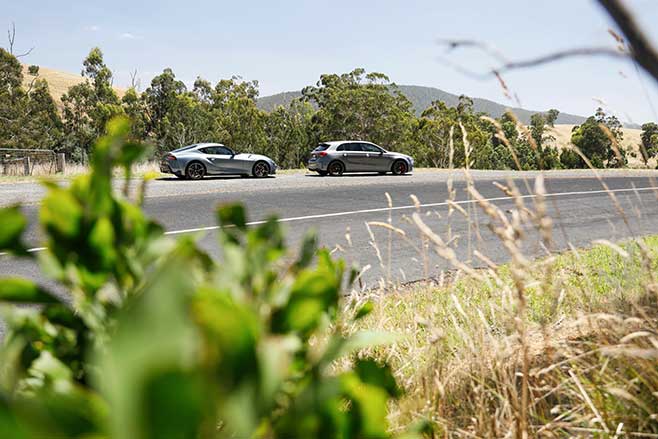
Nevertheless, we have a five-door hatch and a two-door coupe but for the purposes of this comparison we will effectively ignore the A45’s greater luggage and people-carrying capacity – if you need rear doors or seats, there is only one choice for you here.
The only thing we’re concerned with is which is the best driver’s car; after all, these are the two most potent machines you can buy for (just) under $100K but as we’ll discover, while they are within a whisker of each other in outright performance, the way they generate that performance differs dramatically.
The A45 S is a known quantity but its numbers still require a second take: 310kW and 500Nm from a 2.0-litre turbocharged four-cylinder, allied to an eight-speed dual-clutch gearbox and all-wheel drive, resulting in a 0-100km/h claim of 3.9sec and an electronically limited top speed of 270km/h.
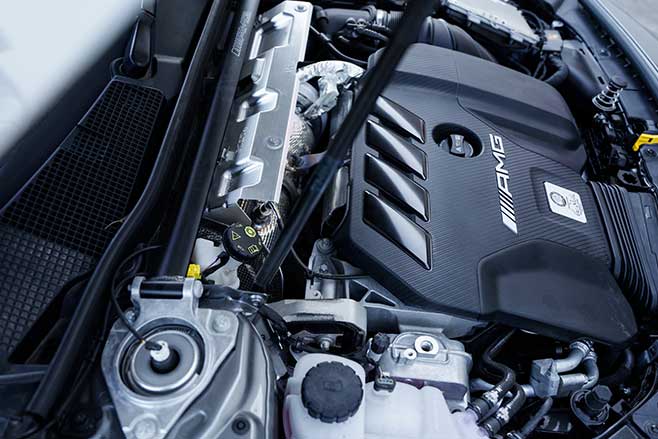
Consider that 20 years ago the Porsche 996 911 Turbo offered 309kW/563Nm and 0-100km/h in 4.2sec. In that context, the A45’s $94,920 price tag doesn’t sting quite so much.It feels like the Supra only appeared last month, but it’s already received its first update, albeit quite a mild one.
The GTS model now has a Supra logo on its red front brake calipers, there are a pair of under-bonnet strut braces to improve rigidity but, most importantly, an extra 35kW has been extracted from the B58 3.0-litre turbocharged straight-six.
Toyota hasn’t just fiddled with the boost, either; the compression ratio has dropped from 11.0:1 to 10.2:1.
Power lifts to 285kW produced between from 5800-6500rpm, and while the torque figure remains static at 500Nm it’s now produced from 1800-5000rpm rather than the 1600-4500rpm of its predecessor.
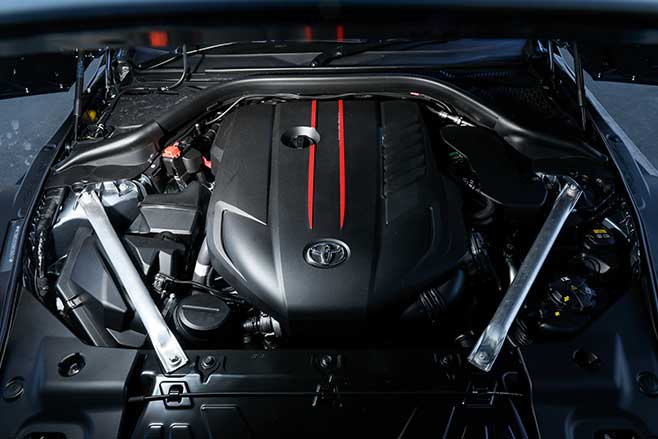
Toyota claims it shaves 0.2sec off the Supra’s 0-100km/h claim, now 4.1sec, while the top speed remains electronically limited to 250km/h.Is the extra grunt really there? From the driver’s seat it sounds the same and feels very quick, but then so did the previous model. Heathcote Raceway will provide the answer.
Our current benchmark Supra figures, recorded at The Bend during Performance Car of the Year 2020 testing, are 0-100km/h in 4.44sec and a 12.62sec quarter mile at 181.16km/h.
The Toyota is not an easy car to launch. Recording consistent 4.6-4.7sec 0-100km/h times is a piece of cake, but edging below that is to walk a Goldilocks tightrope of wheelsmen – not too little, not too much.
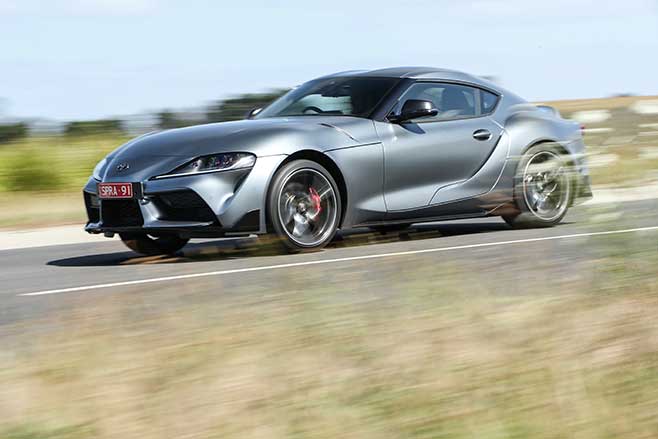
Thankfully, as more rubber goes down, along with some practice, the Supra’s figures start to fall, culminating in a best effort of 4.39sec to 100km/h.
Not a huge improvement, but an improvement nonetheless, and with the scope to shave a couple of tenths from that on a grippier surface.
Beyond 100km/h the Supra’s extra power becomes clearly evident, crossing the quarter-mile in 12.38sec at 188.4km/h, while hitting 200km/h takes 14.04sec.Remember I mentioned these two were close in outright performance? Well, the A45’s best effort to 200km/h was 14.07sec – you can’t get much closer than that.
However, as also mentioned, how the two get to this point is markedly different.
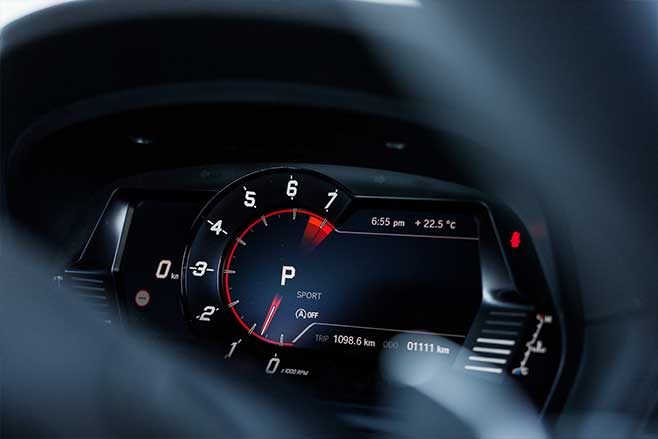
Launch control primed, the A45 bolts off the line and hits 100km/h in 3.94sec and will do so much more consistently than the Supra.
Its advantage has narrowed slightly by the end of the quarter-mile but 12.06sec at 187.03km/h is a clear victory.
Only above 150km/h does the Supra start to claw back ground, which is primarily a function of its shorter fifth gear.Gearing isn’t the world’s most exciting topic – you wouldn’t bring it up at a dinner party – but both these cars take unusual approaches.
Mercedes-AMG figured out a while ago that the secret to blistering acceleration times isn’t just lots of power and all-wheel drive but super-short gearing.
In the A45 first is done at 54km/h, second out of ideas at 77km/h and third only runs to 118km/h, fourth and fifth then stretching out substantially.
The Supra’s gearing is more evenly spaced but still incredibly short for a car with this amount of grunt: 54km/h (1st), 84km/h (2nd), 130km/h (3rd), 164km/h (4th), 215km/h (5th), and each successive gear running into the 250km/h limiter.On the road, this basically means you’re always a gear higher than you expect to be, but such is the response and power band of these cars that it doesn’t catch them off guard.
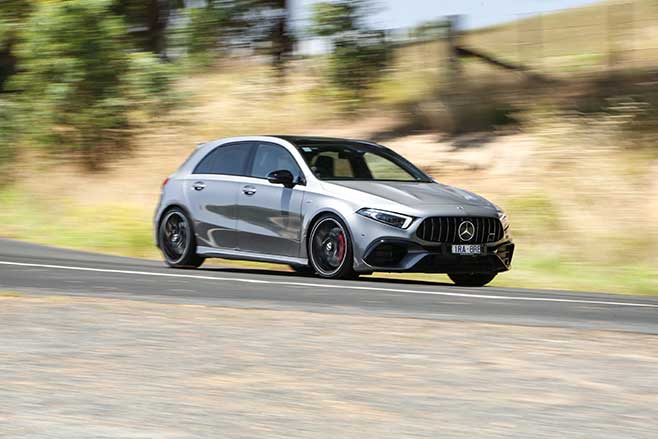
This is probably to be expected in the Supra, with its larger engine developing peak torque from just 1800rpm, but the A45’s 155kW/litre and 5000rpm torque peak suggests an overnight stay in lag city before anything meaningful occurs.Thankfully not, for the A45’s M139 engine defies all logic. Of course, 310kW and 500Nm from 2.0 litres and four cylinders isn’t anything new – tuner cars have been doing it for decades – but for such an engine to have normal servicing intervals, a full manufacturer warranty and last the life of the car is unheard of.
Then there’s the power delivery.
Like Porsche with its 911 Carrera models, AMG has mapped the A45 to more closely replicate the feel of a naturally-aspirated engine; there is a slight hesitation while the turbo wakes up at low rpm, but from there power builds progressively through the mid-range before the tacho needle attacks the 7000rpm redline with unbridled ferocity.
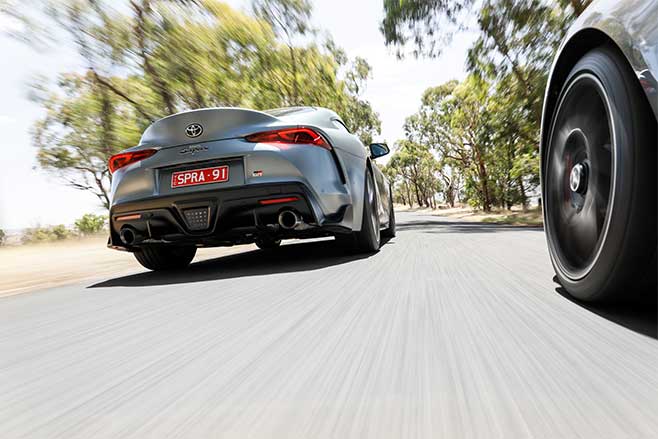
Despite the monstrous outputs, it doesn’t feel in the least bit strained and barks out a hard-edged touring-car style note.
Another area in which AMG has taken a big step forward is transmission programming.
Fast Mercs have historically been lackadaisical in their response to downshift requests but while the new A45 can occasionally feel recalcitrant, that’s more a function of the odd gearing than the gearbox itself – basically, if it can give you a shift it will, zinging the tacho around to 6500rpm on downshifts along with the usual whip-crack upshifts.
The Supra takes a different tack. Its 3.0-litre six hits hard early and tapers off beyond 6500rpm, but that still leaves almost 5000rpm of useable power to play with.
Its softer, mellower sound is more traditionally pleasing but doesn’t have the same attitude.
There’s little to choose between the two in terms of gearboxes; while the Supra has a traditional torque converter auto instead of a dual-clutch, its shifts are quick enough and though it will occasionally refuse a downshift, like the AMG this is more a consequence of the super-short gearing.On a narrow, winding road the Supra is fun. Obviously there’s a lot of component parts that make up the experience but, in essence, they combine to offer the one thing you want from a sports car.
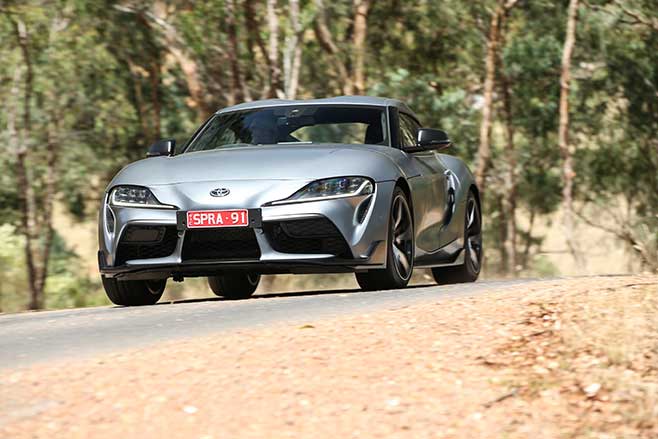
It’s not particularly light at 1505kg, but the weight feels low and centred because there’s an inherent agility in the Toyota.
It rotates very well with strong front-end grip, a process that can be easily assisted with a hefty helping of throttle – it’s classic front-engine, rear-drive dynamics.
The steering is quick at just 2.1 turns lock-to-lock, but it’s very linear in its responses – though selecting Sport adds weight but little else.
Happily, an Individual mode allows the engine, steering and suspension to adjusted separately as road surface or driver preference dictates.It’s very easy to settle into a quick, comfortable flow with the Toyota, though as the pace increases there feels to be a slight disconnect between the steering’s rate of response and that of the chassis, the latter being a fraction of a second behind the former.
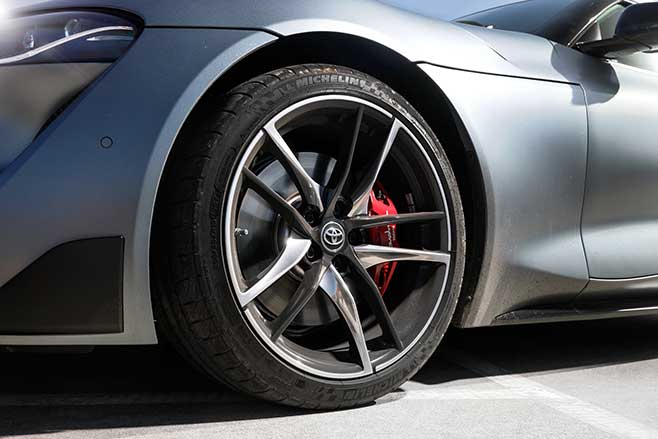
Bumpy roads also require caution as the Supra can be a wild, bucking and bouncing ride, the short wheelbase (almost 300mm less than the A45) keeping the driver busy with a constant need for correction.
Traction is strong, but the extra power has the rear end squirming satisfyingly from a standing start and with the electronics relaxed power oversteer is there for the taking in the first three gears.
On the same narrow, winding road, the Merc’s acceleration is puckeringly brisk, the steering tugging left and right as the front wheels follow ridges and cambers.
Nothing too untoward, but it focuses the mind in something this fast.

Like in the Supra, bumpier roads can trouble the A45’s short-travel suspension, but all-wheel drive, slower steering and a more substantial footprint means the experience isn’t as frenetic.In fact, in Comfort or Sport at a quick but comfortable pace, Merc’s ultimate hot hatch reveals little of its personality. It doesn’t feel particularly comfortable, either, primarily due to the steering.
After the Supra it feels slow and unresponsive, lacking the same off-centre immediacy, but then there seems to be a sudden jump in response once you pass a quarter-turn of lock.
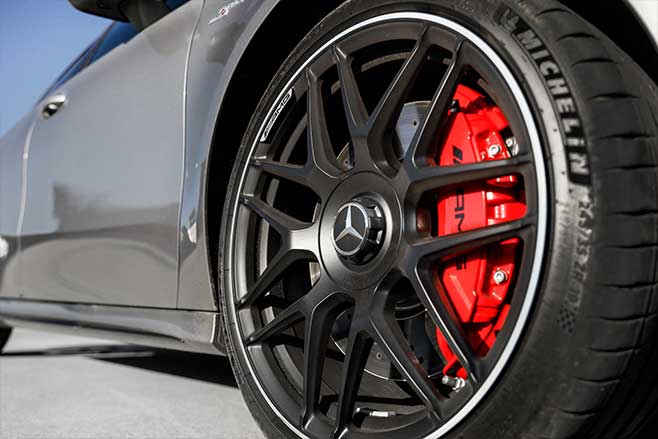
You just need to up the pace. The new A45 expects, nay demands, you drive the wheels off it and in doing so you discover AMG has listened closely to any and all criticisms of the original.
Even in the stiffer damper modes there’s compliance, giving the 245/35 Michelin Pilot Sport 4 S rubber the best chance possible of staying in contact with the tarmac; you soon become used to the larger inputs the steering requires but it’s also far less important than previously thanks to a thorough overhaul of the 4MATIC system.
I’ve never driven an all-wheel-drive car that rotates as quickly as the A45, though. As soon as you apply the throttle it pivots sharply to such a degree that it forces a driving style adjustment; you need to wind lock off much earlier than you expect as the diffs have completed much of the turn for you.
Combine this with a chassis that has the adjustability of a well-honed front-drive hot hatch, and suddenly you have a smorgasbord of cornering options previously unavailable to A45 drivers.
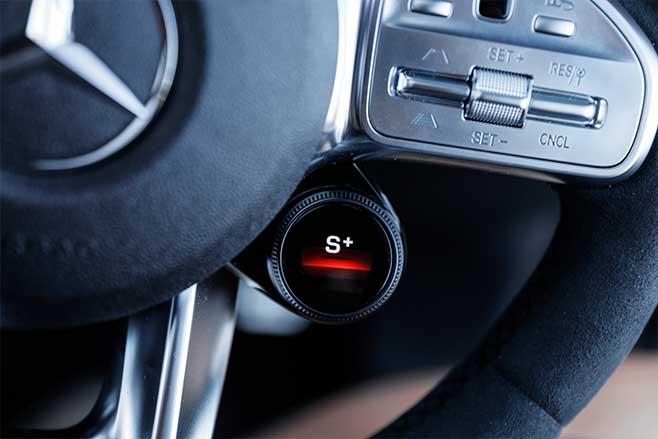
Should the rear end edge wide under brakes, add a bit of throttle to straighten the ship; if the front pushes wide, instead of needing to wait for it to re-connect a dose of accelerator fixes the understeer by rotating the rear; finally, if everything is tidy mid-corner, a hefty helping of power will produce the sort of oversteer that V8 AMG drivers will be familiar with.
The A45 has clearly been set up to behave in this manner and as such it could be called contrived, but when the end result is this enjoyable, does it really matter?It works on track, too. Against expectations, the tight confines of Bryant Park Hillclimb doesn’t suit the A45.
It feels hemmed in and many of the corners sit smack-bang in the middle of second and third gear.
Having also tried the car previously at Winton and Phillip Island on a more traditional circuit the A45 is awesome, its combination of stability and adjustability making it confidence-inspiring yet hugely enjoyable.
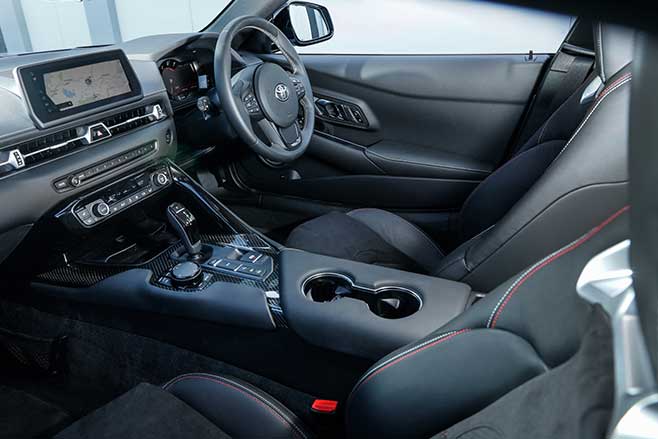
Swap the circuit for the daily grind and, again, there is little to split the two (discounting the A45’s five doors and five seats, of course), though for different reasons.
Both have fairly firm rides with just enough give to prevent complaint but road noise is a price that must be paid for the performance on offer.
The Supra’s driving position is superior, albeit in a much ‘cosier’ interior, and overall quality is of a higher level but storage space is at a premium and there’s no smartphone mirroring.

The A45’s highs are higher, particularly in terms of design and equipment, but the proliferation of cheap materials throughout the cabin is disappointing in a $100,000 car.But it’s also forgivable, because the mechanicals must cost a bomb.
If you’ve ever wondered what the ultimate evolution of the Mitsubishi Lancer, er, Evolution would be, then the A45 S answers that question.
It’s a vast improvement on its predecessor; not just faster but much more engaging and enjoyable at the limit.
But then so it should be, as the price tag has increased by almost $20K.
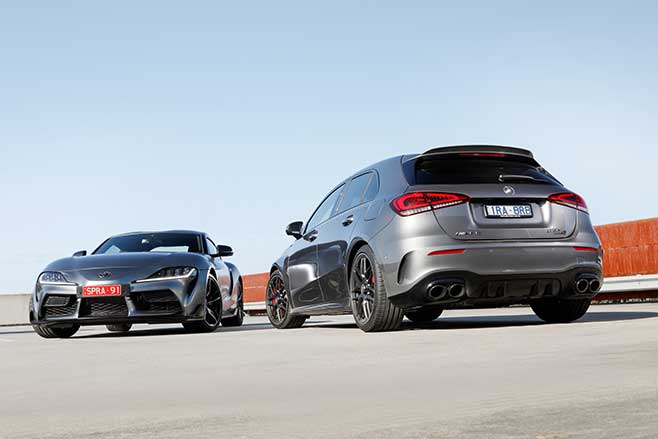
The engine is berserk, the bandwidth is broader and on the right road it’s a riot, but it does need the right road.
In comparison, the Supra works pretty much everywhere and is also more enjoyable when you’re not driving like a maniac.
If you’re prepared to forgo a few fripperies, the lower-spec GT also offers exactly the same experience for $10K less, which is a handy price advantage.
In the end, this test wasn’t so much Germany versus Japan as technology versus tradition.
In this instance, tradition gets the nod by the smallest of margins.SPECIFICATIONS
Mercedes-AMG A 45 S
4.5/5
Pros: Amazing engine; new-found playfulness Cons: Cheap interior bits; road noise
Body: 5-door, 5-seat hatch Drive: all-wheel Engine: 1991cc inline-4cyl, DOHC, 16v, turbo Bore/stroke: 83.0 x 92.0mm Compression: 9.0:1 Power: 310kW @ 6750rpm Torque: 500Nm @ 5000-5250rpm Power/weight: 200kW/tonne Transmission: 8-speed dual-clutch Weight: 1550kg Suspension: struts, coil springs, adaptive dampers, anti-roll bar (f); multi-links, coil springs, adaptive dampers, anti-roll bar (r) L/W/H: 4445/1850/1412mm Wheelbase: 2729mm Tracks: 1579/1558mm Steering: electrically assisted rack-and-pinion Brakes: 360mm ventilated/drilled discs, 6-piston calipers (f); 330mm ventilated/drilled discs, single-piston calipers (r) Wheels: 19 x 8.5-inch (f/r) Tyres: 245/35 ZR19 (f/r); Michelin Pilot Sport 4 S Price: $94,920Toyota Supra GTS
4.5/5
Pros: Agile, natural handling; extra grunt Cons: Road noise; small cabin; GT is $10K cheaper
Body: 2-door, 2-seat coupe Drive: rear-wheel Engine: 2998cc inline-6cyl, DOHC, 24v, turbo Bore/stroke: 82.0 x 94.6mm Compression: 10.2:1 Power: 285kW @ 5800-6500rpm Torque: 500Nm @ 1800-5000rpm Power/weight: 189kW/tonne Transmission: 8-speed automatic Weight: 1505kg Suspension: struts, coil springs, adaptive dampers, anti-roll bar (f); multi-links, coil springs, adaptive dampers, anti-roll bar (r) L/W/H: 4379/1854/1294mm Wheelbase: 2470mm Tracks: 1594/1589mm Steering: electrically assisted rack-and-pinion Brakes: 348mm ventilated discs, 4-piston calipers (f); 345mm ventilated discs, single-piston calipers (r) Wheels: 19 x 9.0-inch (f); 19 x 10.0-inch (r) Tyres: 255/35 ZR19 (f); 275/35 ZR19 (r) Michelin Pilot Super Sport Price: $97,126






